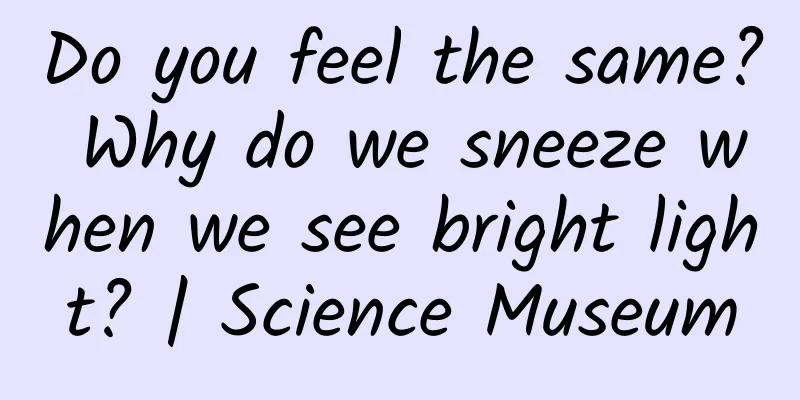Do you feel the same? Why do we sneeze when we see bright light? | Science Museum

|
Have you ever seen this phenomenon: you are fine at ordinary times, but when you encounter strong light, you will sneeze uncontrollably. Why is this? To solve this problem, let’s first take a look at what sneezing is. There are many reasons for sneezing, including rhinitis, acute rhinitis caused by upper respiratory tract infection, irritation of nasal mucosa, etc. In addition, increased secretions or scabs in the nasal cavity can also irritate the nasal mucosa and cause sneezing. Of course, strong light is also a reason to some extent. "Strong light makes people sneeze" is not a new topic. As early as the ancient Greek period, people had doubts about this issue, and there were many different opinions. It was not until neurobiologists joined this big "group chat" that the truth slowly surfaced. Physicist H.C. Everett proposed a new term for this phenomenon, "light sneeze reflex", and described it in the Journal of Neurology in 1964. As scientists continue to conduct in-depth research, the principle of the "optical sneeze reflex" has gradually become clear. The light sneeze reflex is also called the "optical sneeze reflex". About 10% to 35% of the population will easily experience nasal itching and sneezing when seeing sunlight or strong light. Because in the human body structure, the visual receptors and olfactory receptors are very close in distribution, and the two are involved in forming the visual reflex arc and the olfactory reflex arc respectively. In other words, the perception of the eyes and nose is controlled by the same trigeminal nerve. It is precisely because of the close relationship between the two that they are often confused. When the human eye is exposed to strong light, the optic nerve sends a distress signal to the brain, instructing the brain to quickly shrink the pupil to prevent the strong light from hurting the eyes. However, due to the close relationship between the optic nerve and the olfactory nerve, this signal is sometimes mistaken by the olfactory nerve as irritation of the nose, which then orders a sneeze to relieve the irritation. This is how the "light sneeze reflex" is born. In addition, another possible reason why the photo sneeze reflex can be induced is that the eyes may be filled with tears under the stimulation of strong light. Tears are an excessive secretion of the tear ducts, which can themselves stimulate the occurrence of sneezing, just like when tears are not caused by strong light. Moreover, when we look up at the sun, tears flow out of the eye sockets due to the influence of gravity, which further stimulates the eyes and causes the photo sneeze reflex. According to relevant statistics, the sneezing reflex induced by sunlight often occurs in infants under 3 years old. This is because the division of labor of various nerve centers in developing infants has not reached the sophisticated level of adults, so they are easily confused by some external stimuli. Some people sneeze easily when plucking their eyebrows, and the reason is similar to the stimulation of strong light. The phenomenon of tears flowing when plucking nose hair is just the opposite example. When the nose is stimulated, the eyes have a defensive reaction, so tears flow to wash out the foreign body. A genetic study in the 1960s showed that this "confusion" between nerves is an autosomal dominant trait, and only one gene copy is needed to express this trait, that is, the "light sneeze reflex" phenomenon is hereditary. If one of the parents has this physique, then more than half of their children will inherit this physique. In 1978, a study officially called this phenomenon "compulsive autosomal dominant hereditary photoreflex syndrome." However, this physique belongs to a minority, and it is just a common biological genetic phenomenon, not a disease. Have you ever had similar experiences in your life? Welcome to leave a message in the comment area~ Let Fatke see how big this group is! Creative team: China Science and Technology Museum New Media Team Review expert: Yin Tielun, deputy chief physician of the Department of Neurology, Airport Branch, Peking University Third Hospital |
<<: Why is the supermoon so big?
Recommend
Ocean Love Story Series丨Anglerfish——This Sticky Love
Author: Scientific Scraps Reviewer: Zhang Wei, As...
The latest paper in Nature: Is it important to have water in your head?
In recent years, there is a "glymphatic clea...
Group psychological counseling and treatment practice, technical analysis and application of authoritative teachers 60+ lessons 140 HD video full version
Practical group counseling and treatment, technica...
Goldman Sachs: Virtual reality market could reach $80 billion in 10 years
Many seemingly beautiful technologies always fall...
"Internet +" reshapes smart home
1. Report Summary: Smart home is one of the "...
Is it just games that WeWhale is trying to grab in the e-sports market again by taking advantage of NEST2015?
As Internet companies and traditional home applia...
Thousand-word summary of the AARRR model’s retention methodology
Today we will continue with the user growth and r...
How to attract new users and increase growth?
Because there is no growth, growth is imminent! A...
Will the electric eel shock itself when it discharges electricity?
The Amazon is a place with extremely rich biologi...
Counterpoint: European passenger electric vehicle sales increased 17% year-on-year in Q3 2022
According to the latest research from Counterpoin...
Colds and allergies come after the Spring Equinox! You need a correct protection "secret"
After the spring equinox, the temperature gradual...
How to analyze user needs and build a user system?
1. What is the user system? Before talking about ...
My Primary Growth Map
The Internet has developed to this stage, and the...
ARM's DynamlQ technology redefines multi-core by enabling smartphones to have both high performance and low energy consumption
The computing field has always been pursuing high...
I fart dozens of times a day and they smell really bad. Is there something wrong with my intestines?
One of Huazi's friends blushed and told Huazi...









